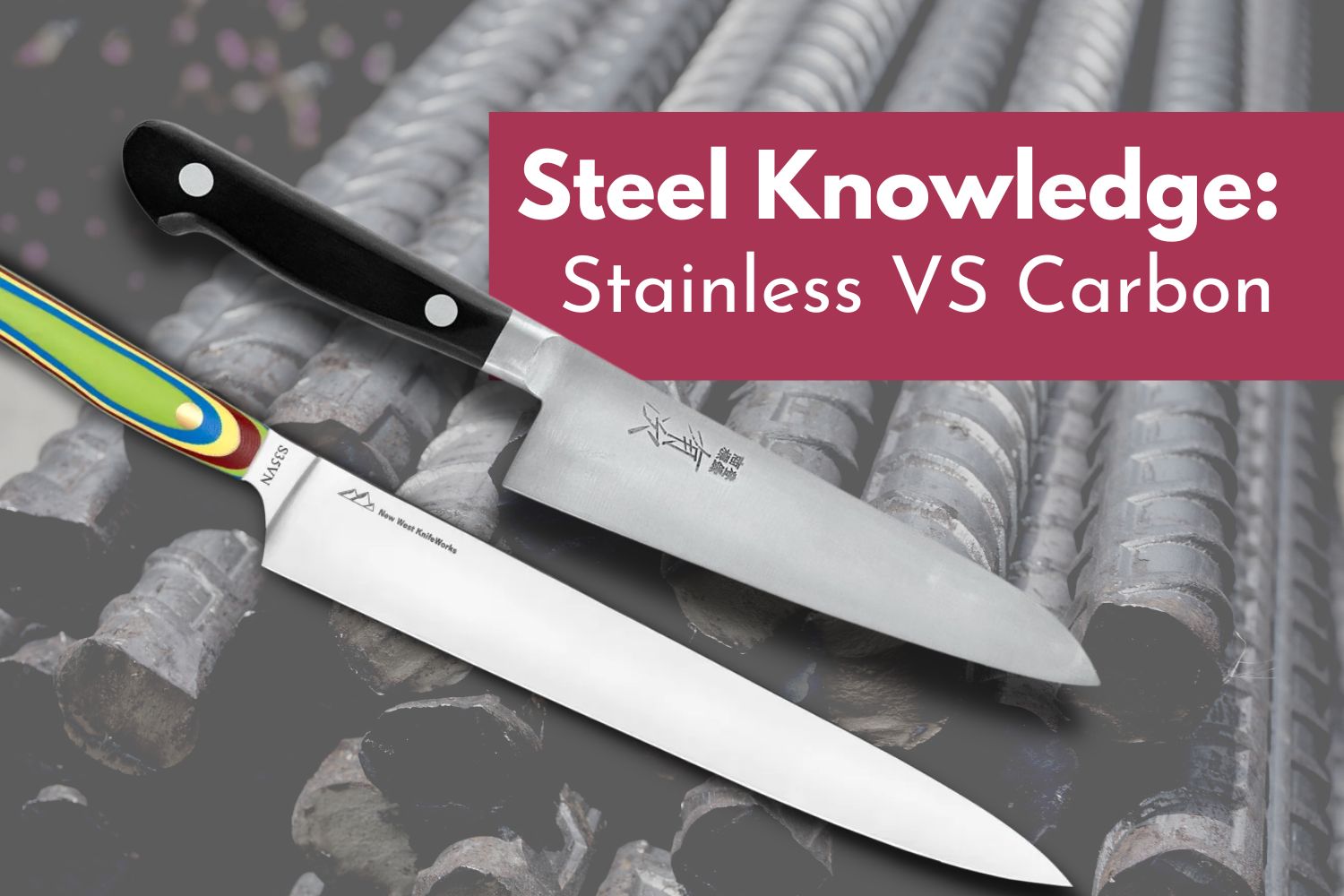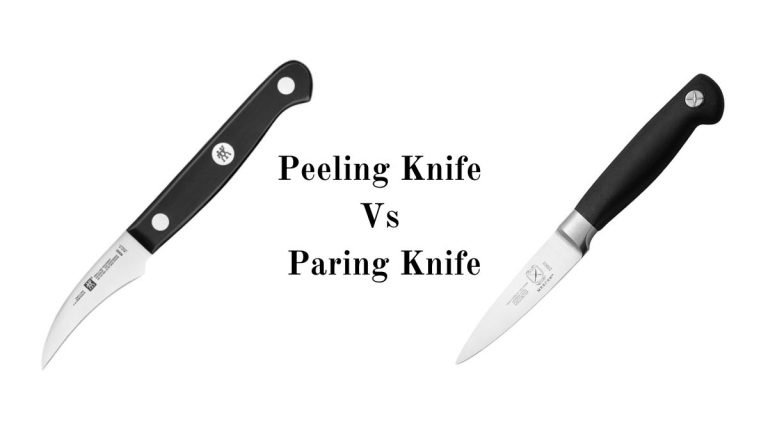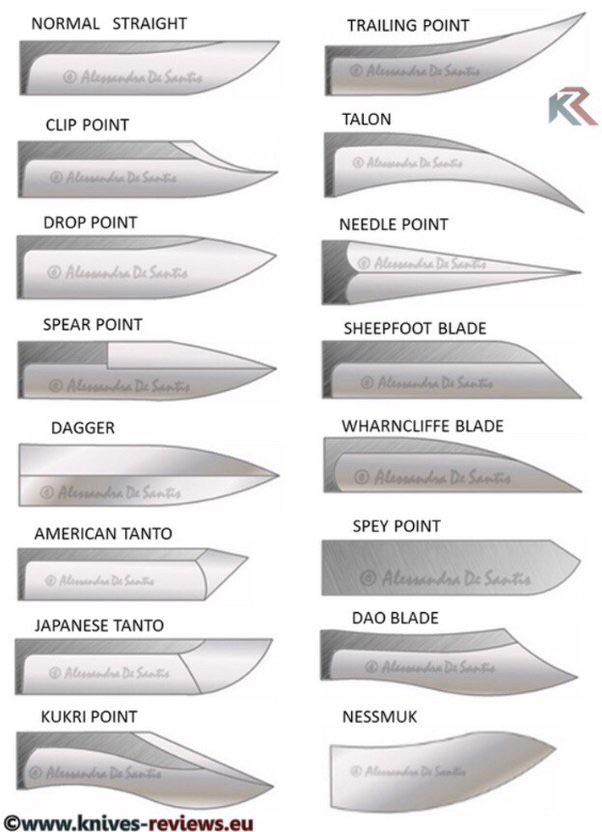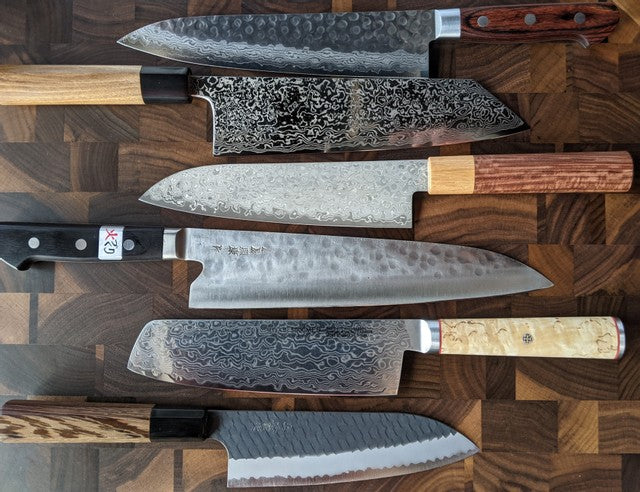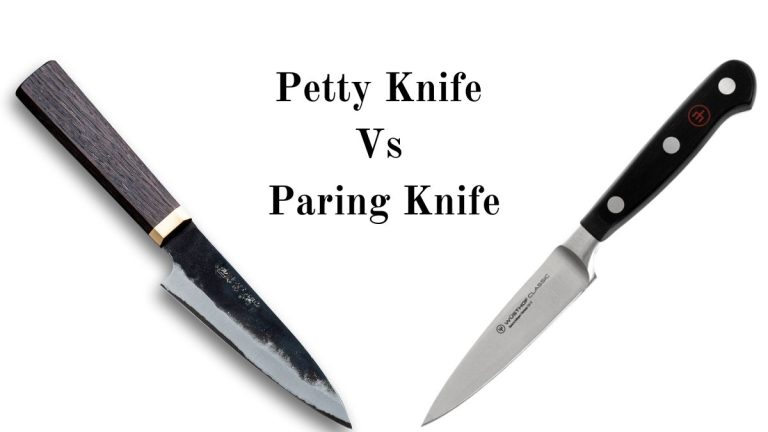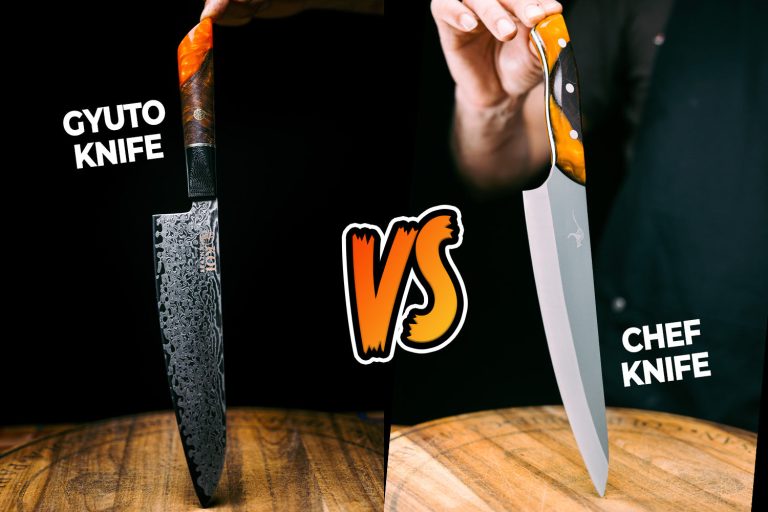Carbon Steel Vs Stainless Steel Knife: Which is Right for You?
Choosing between carbon steel and stainless steel knives can be tough. Both have unique qualities.
Understanding the differences helps you pick the best knife for your needs. Carbon steel knives are known for their sharpness and edge retention. Stainless steel knives are famous for their resistance to rust and low maintenance. This comparison will explore the strengths and weaknesses of each type.
By the end, you’ll know which knife suits your cooking style better. Dive in to discover what sets these knives apart.

Introduction To Knife Materials
Choosing the right knife material is crucial for performance and durability. Whether you are a professional chef or a home cook, understanding the differences between carbon steel and stainless steel knives can help you make an informed decision.
Importance Of Knife Material
The material of a knife affects its sharpness, strength, and longevity. A good knife material ensures that the knife stays sharp longer and resists wear and tear. It also determines how easy the knife is to maintain and clean.
Common Knife Materials
There are two popular materials for knives: carbon steel and stainless steel. Each has its advantages and disadvantages.
Carbon steel knives are known for their sharpness and edge retention. They are often used by professional chefs who need precision. But they require regular maintenance to prevent rust and corrosion.
Stainless steel knives, on the other hand, are resistant to rust and stains. They are easy to maintain and are ideal for everyday use. However, they may not hold an edge as well as carbon steel knives.
What Is Carbon Steel?
Carbon steel is a popular material for making knives. It consists of iron and carbon. This combination gives carbon steel its unique properties. It is well-known for its strength and durability.
Composition Of Carbon Steel
Carbon steel contains two main elements:
- Iron: Makes up the majority of the steel.
- Carbon: Usually ranges from 0.12% to 2.0%.
Sometimes, small amounts of other elements are added. These might include:
- Manganese
- Silicon
- Sulfur
- Phosphorus
These elements improve the steel’s properties. For example, manganese increases hardness. Silicon adds strength.
Properties Of Carbon Steel
Carbon steel has several key properties:
| Property | Description |
|---|---|
| Hardness | Carbon steel is very hard. This makes it great for sharp, durable knives. |
| Strength | It is very strong. This means it can handle tough tasks without bending or breaking. |
| Sharpness | Carbon steel knives can be very sharp. They are ideal for precise cutting. |
| Corrosion | Carbon steel is prone to rust. It needs regular maintenance to stay in good condition. |
Overall, carbon steel is a solid choice for knives. Its strength and sharpness make it a favorite among chefs and knife enthusiasts.
What Is Stainless Steel?
Stainless steel is a popular material for knives. It is known for its durability and resistance to rust. Many people prefer stainless steel knives for their reliability.
Composition Of Stainless Steel
Stainless steel is an alloy. It mainly consists of iron, chromium, and carbon. Chromium is the key element. It gives stainless steel its corrosion resistance. The chromium content in stainless steel is at least 10.5%. This helps form a thin protective layer on the steel surface.
Nickel and molybdenum may also be added. These elements enhance strength and resistance to harsh conditions. The exact composition can vary. Different grades of stainless steel exist for various applications.
Properties Of Stainless Steel
Stainless steel has several important properties. It resists rust and corrosion, making it ideal for kitchen environments. It is also known for its strength and durability. Stainless steel knives remain sharp for a long time.
Another key property is its ease of maintenance. Stainless steel knives are easy to clean. They do not require special care to prevent rust. This makes them a convenient choice for many users. Lastly, stainless steel has a sleek, modern appearance. This aesthetic appeal is a bonus for many knife enthusiasts.
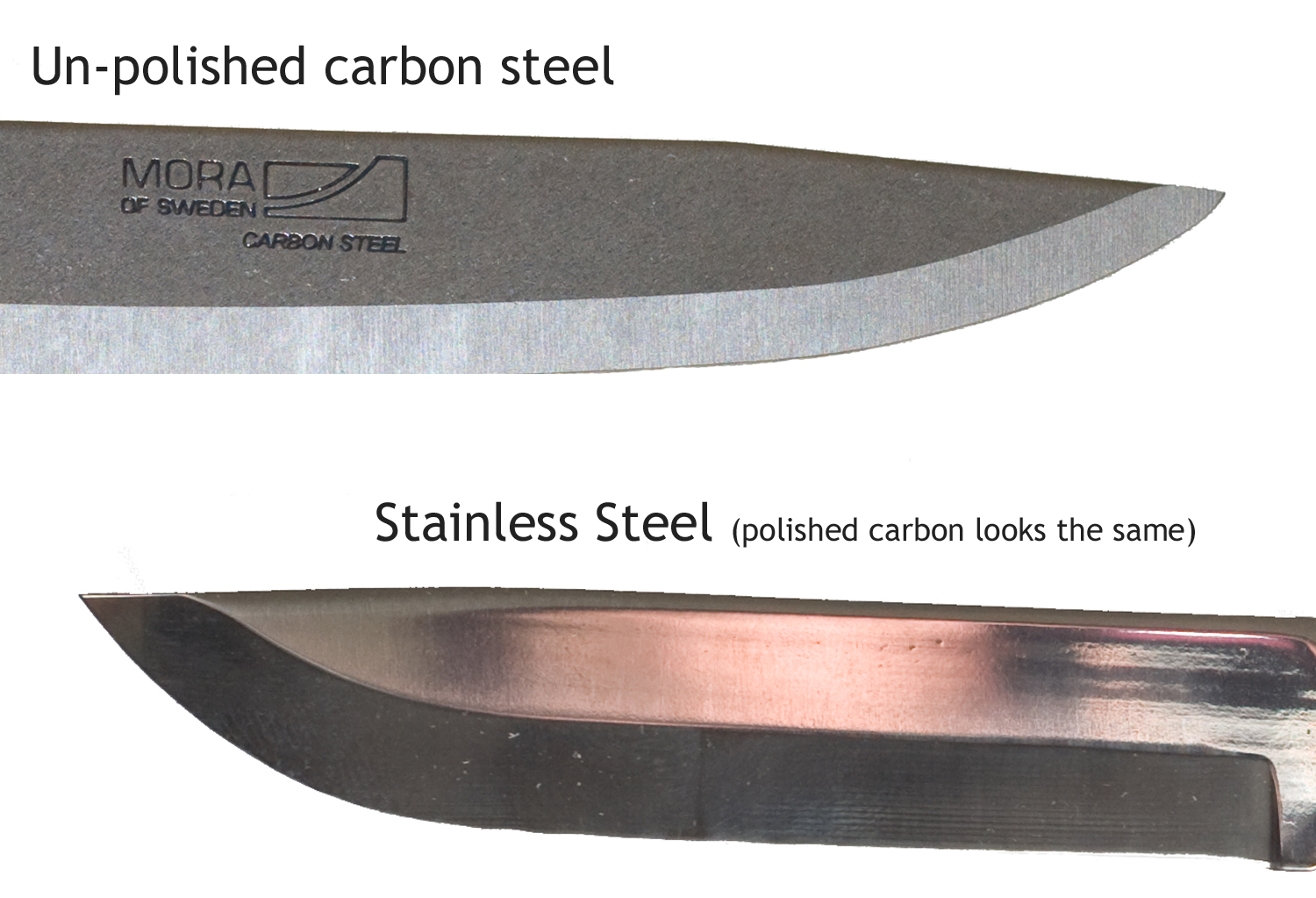
Credit: www.greenmanbushcraft.co.uk
Performance Comparison
Choosing between a carbon steel knife and a stainless steel knife can be tough. Both have unique strengths. This section will compare their performance, focusing on edge retention and sharpness.
Edge Retention
Edge retention is how long a knife stays sharp with regular use. Carbon steel knives usually have better edge retention. The high carbon content makes the blade harder. This means the edge remains sharp for a longer time.
Stainless steel knives do not stay sharp as long. They are softer because they contain chromium. This metal provides rust resistance but affects hardness. So, you may need to sharpen them more often.
Here is a simple comparison:
| Steel Type | Edge Retention |
|---|---|
| Carbon Steel | Long-lasting |
| Stainless Steel | Shorter duration |
Sharpness
Sharpness is how fine the edge of the blade is and how well it cuts. Carbon steel knives can achieve a razor-sharp edge. They can be sharpened to a finer point. This makes them ideal for precise cutting tasks.
Stainless steel knives can also be very sharp. But they might not reach the same level of sharpness as carbon steel. They are more user-friendly because they are easier to maintain and clean.
Here is a quick look at their sharpness:
| Steel Type | Sharpness |
|---|---|
| Carbon Steel | Razor-sharp |
| Stainless Steel | Very sharp |
In summary, carbon steel knives excel in both edge retention and sharpness. Stainless steel knives are easier to maintain but need more frequent sharpening.
Durability And Maintenance
Durability and maintenance are crucial factors when choosing between carbon steel and stainless steel knives. Each material offers unique benefits and challenges. Understanding these can help you make an informed decision. This section delves into the differences in rust resistance and ease of maintenance for both types of knives.
Rust Resistance
Rust resistance is a significant factor in knife durability. Stainless steel knives excel in this area. Their high chromium content forms a protective layer, preventing rust. This makes them ideal for humid or wet environments.
In contrast, carbon steel knives are more prone to rust. They lack the chromium content found in stainless steel. This means extra care is needed to keep them dry and clean. Regular oiling can help prevent rust on carbon steel knives.
Ease Of Maintenance
Maintaining a knife’s sharpness and appearance is important. Stainless steel knives are easier to maintain. Their rust resistance means less frequent cleaning and oiling. They require less effort to keep in good condition.
Carbon steel knives need more attention. They must be cleaned and dried immediately after use. This prevents rust and maintains their sharpness. Regular sharpening and oiling are also necessary. This ensures they remain effective and look good.
Price And Availability
When choosing between carbon steel and stainless steel knives, price and availability are important factors. Both types of knives have distinct cost structures and market presence. Understanding these elements can help make an informed decision.
Cost Factors
Carbon steel knives are usually more affordable. The materials and manufacturing process contribute to the lower price. They tend to require less complex production methods. Stainless steel knives, on the other hand, are often pricier. The addition of chromium and other alloys increases the cost. Crafting stainless steel involves more advanced techniques.
Price differences also depend on brand and craftsmanship. High-end brands offer both types at premium prices. Handmade knives also command higher prices due to labor and skill involved. Budget-friendly options exist in both categories but vary in quality. Always consider long-term value and durability when weighing cost.
Market Availability
Carbon steel knives are less common in regular stores. They are often found in specialty shops or online. These knives appeal to professional chefs and enthusiasts. Stainless steel knives are widely available. You can find them in supermarkets, department stores, and online. Their popularity makes them easier to source.
The range of options is broader for stainless steel knives. Brands offer various designs and features. Carbon steel knife options are more limited but often higher quality. Limited availability does not mean lower quality. It often means a more niche market.
Best Use Cases
Choosing between carbon steel and stainless steel knives depends on their use cases. Each type of steel offers unique benefits tailored to specific tasks. In this section, we will explore the best use cases for both carbon steel and stainless steel knives.
Carbon Steel Applications
Carbon steel knives excel in precise cutting tasks. Chefs prefer them for slicing vegetables and fruits. They also excel in making thin, clean cuts of meat. Butchers often use carbon steel for its sharpness. Hunters and outdoor enthusiasts favor carbon steel for field dressing. These knives hold their edge longer, reducing the need for frequent sharpening.
Stainless Steel Applications
Stainless steel knives are ideal for tasks requiring durability. They resist rust, making them perfect for wet environments. Fishermen use them for filleting and cutting fish. Home cooks appreciate their low maintenance in busy kitchens. Stainless steel is also popular in professional settings. Chefs use them for chopping, dicing, and general kitchen work. These knives are dishwasher safe, saving time on cleanup.
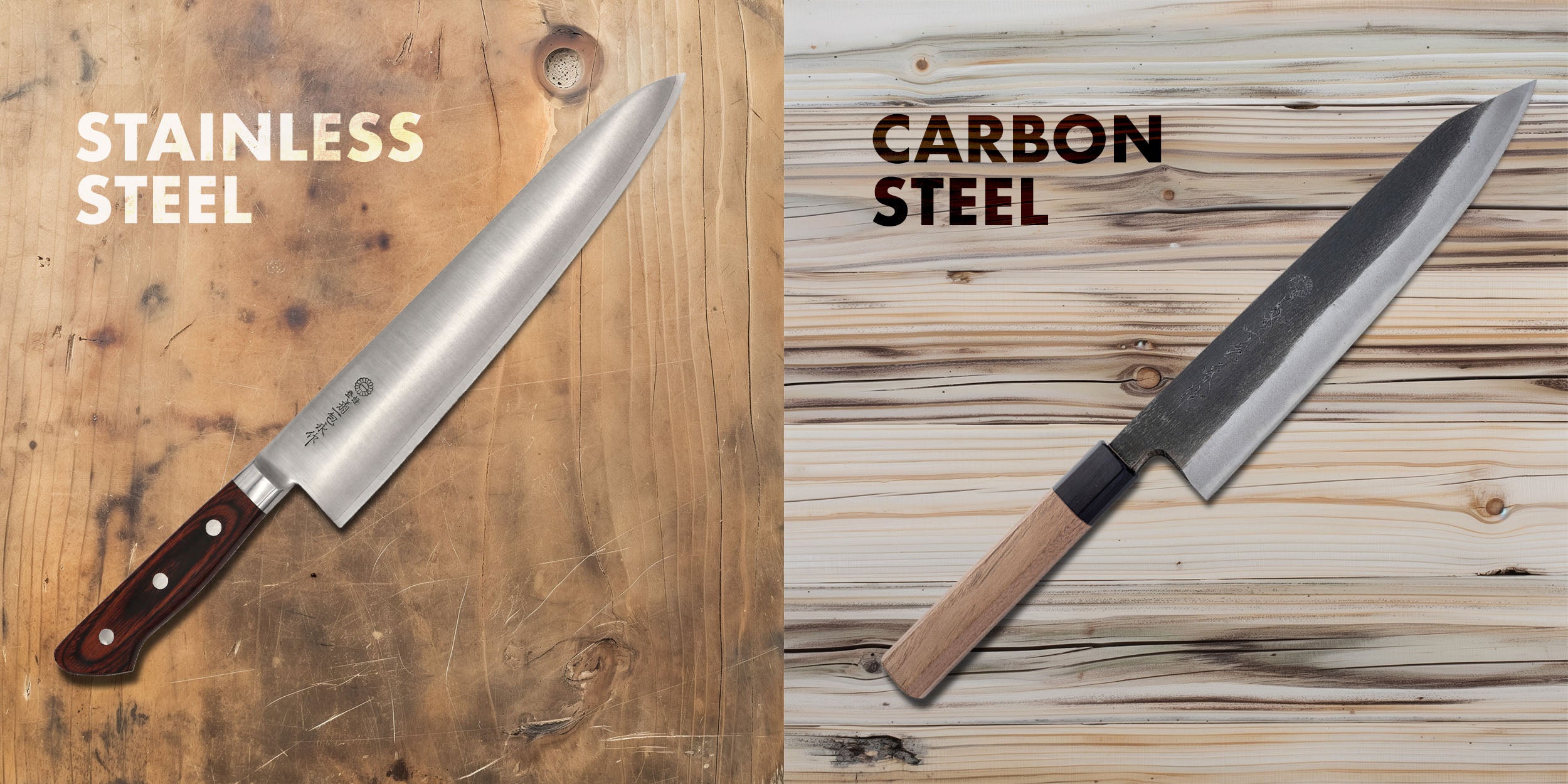
Credit: elementknife.com
Making The Right Choice
Choosing between a carbon steel knife and a stainless steel knife can be challenging. Each type has its benefits and drawbacks. Understanding these can help you make the best decision for your needs. This section will explore personal preferences and intended use to help guide your choice.
Personal Preferences
Personal preferences play a significant role in knife selection. Some people prefer the look and feel of carbon steel knives. They often have a rustic charm and a sharper edge. Yet, they require more maintenance to avoid rust.
Stainless steel knives, on the other hand, are low maintenance. They resist rust and stains. This makes them ideal for those who prefer less upkeep. Their sleek, modern appearance also appeals to many users.
Intended Use
Intended use is another crucial factor in choosing the right knife. For heavy-duty tasks, a carbon steel knife is ideal. It stays sharp longer and cuts through tough materials with ease.
Stainless steel knives are perfect for everyday kitchen tasks. They handle slicing, dicing, and chopping with precision. Their durability and resistance to corrosion make them suitable for frequent use.
In summary, consider your personal preferences and intended use. These factors will help you decide between a carbon steel or stainless steel knife.
Frequently Asked Questions
Which Is Better, Carbon Steel Or Stainless Steel Knife?
Carbon steel knives are known for their sharpness and edge retention. Stainless steel knives are more resistant to rust and corrosion. The choice depends on your preference for maintenance and use.
Do Carbon Steel Knives Rust Easily?
Yes, carbon steel knives are prone to rust if not properly maintained. Regular cleaning and drying are essential. Applying a thin layer of oil can prevent rust.
Are Stainless Steel Knives Easier To Maintain?
Yes, stainless steel knives require less maintenance than carbon steel knives. They are resistant to rust and corrosion. Regular cleaning and drying are still necessary to maintain their quality.
Which Knife Stays Sharp Longer?
Carbon steel knives stay sharp longer due to their hardness. However, they require more maintenance to prevent rust. Stainless steel knives may need frequent sharpening but are easier to care for.
Conclusion
Choosing between carbon steel and stainless steel knives depends on your needs. Carbon steel offers sharpness and easy sharpening. Stainless steel provides rust resistance and low maintenance. Both have pros and cons. Consider your cooking habits and preferences. Think about your budget too.
Ultimately, pick the knife that fits your lifestyle best. Happy cooking!

